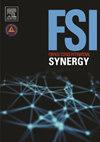珀尔斯普鲁士蓝染色及普鲁士蓝和特恩布尔蓝的化学性质
Q1 Social Sciences
引用次数: 0
摘要
珀尔斯普鲁士蓝染色或反应用于检测血红素,这是储存或隔离的非血红素铁。方法上,血黄素中的铁被盐酸(HCl)释放为Fe3+ (FeIII), FeIII与亚铁氰化钾(K4[FeII(CN)6])反应生成普鲁士蓝。铁蛋白释放的铁是另一种储存的非血红素铁,由于太稀少而无法检测到。血红铁,包括血红蛋白和细胞色素,不被盐酸释放。因此,在显微镜下可以很容易地检测到血黄素为明显的蓝色沉积物,背景染色最小。氰化物桥接铁络合物的化学性质,包括普鲁士蓝和特恩布尔蓝,是理解珀尔斯染色的基础。普鲁士蓝是由FeII或FeIII离子交替排列在边角形成fei - cn - FeIII结构的立方晶格。从物理化学上讲,普鲁士蓝可溶于水(以胶体的形式分散)或不溶于水,这取决于它是如何形成的。与珀尔斯染色一样,普鲁士蓝预计会以可溶性形式存在,因为与组织释放的Fe3+相比,过量的K4[FeII(CN)6]。值得注意的是,珀尔斯染色中使用的普鲁士蓝实际上不会消散在染色溶液中,而是留在组织上,使其成为一种实用的组织学检测血红素和具有法医意义的外源性铁的方法。但是,需要进一步审查其机制,以评估该方法在各种法医案件中的适用性。本文章由计算机程序翻译,如有差异,请以英文原文为准。
Perls' Prussian blue staining and chemistry of Prussian blue and Turnbull blue
Perls’ Prussian blue staining or reaction is used to detect haemosiderin, which is stored or sequestrated non-haeme iron. Methodologically, the iron in haemosiderin is released as Fe3+ (FeIII) by hydrochloric acid (HCl), and FeIII reacts with potassium ferrocyanide (K4[FeII(CN)6]) to form Prussian blue. Iron released from ferritin, another stored non-haeme iron, is too scarce to be detected. Haeme iron, including haemoglobin and cytochromes, is not released by HCl. Thus, haemosiderin can easily be detected under the microscope as distinct blue deposits with minimal background staining. The chemistry of cyanide-bridged iron complexes, including Prussian blue and Turnbull blue, is the basis for understanding Perls' staining. Prussian blue is a cubic lattice with FeII or FeIII ions alternately aligned at the corners to give FeII–CN–FeIII formations at the edges. Physicochemically, Prussian blue is soluble in water (dispersible as a colloid) or insoluble depending on how it is formed. As with Perls' staining, Prussian blue is expected to take a soluble form because of excess K4[FeII(CN)6] compared to Fe3+ released from tissues. Notably, Prussian blue used in Perls' staining does not in fact dissipate into the staining solution but remains on the tissue, rendering this a practical method for histological detection of haemosiderin and also exogenous iron of forensic significance. However, further examinations of its mechanisms are needed to evaluate the applicability of this method on various forensics cases.
求助全文
通过发布文献求助,成功后即可免费获取论文全文。
去求助
来源期刊

Forensic Science International: Synergy
Social Sciences-Law
CiteScore
4.90
自引率
0.00%
发文量
75
审稿时长
90 days
 求助内容:
求助内容: 应助结果提醒方式:
应助结果提醒方式:


